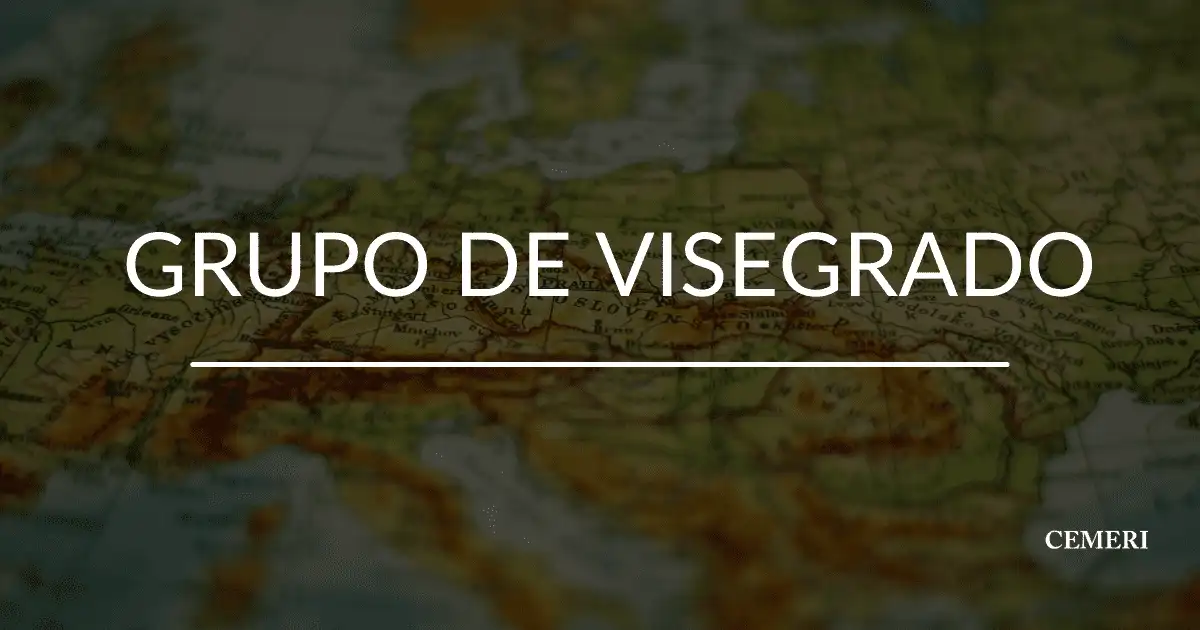Encyclopedia
Marco Olivera
What is the Visegrad Group?
- The alliance has a historical origin in the Visegrad Pact of 1335, establishing a mutual non-aggression agreement between the kingdoms of Central Europe and collaboration on political and economic issues.

The Visegrad Group, also called V4, is the conformation of the political alliance of Czech Republic, Slovakia, Hungary and Poland, countries of Central Europe. The history of the Visegrad Group is one of unexpected success, which continues to consolidate itself as an important regional formation, key to coordinating the international objectives of its members.
The Group takes its name from the Castle of the Hungarian city on the banks of the Danube where its founding act was signed. Throughout history, the rapprochement between these countries has been constant due to factors such as their geographical proximity, culture, values and interests. On February 15, 2021, the presidents of Hungary, Slovakia, the Czech Republic and Poland held a [meeting to commemorate the 30th anniversary](https://www.swissinfo.ch/spa/visegrado-ue--previsi%C3%B3n -_the-l%C3%ADders-of-visegrád-celebrate-a--club--that-makes-them-m%C3%A1s-strong-/46378430) of the Visegrad Group, in Krakow.
Slovakian Prime Minister Igor Matovic, European Council President Charles Michel, Polish Mateusz Morawiecki, Hungarian Viktor Orban and Czech Prime Minister Andrej Babis at the Wawel Castle in Krakow during the 30th anniversary of the founding of the Visegrad Group. Photo: Council of the European Union
History of the Visegrad Group
The alliance between these four countries has a historical origin in the Visegrad Pact of 1335, whose objective was to establish a mutual non-aggression agreement between the kingdoms of Central Europe and collaboration on political and economic issues. The conference is known as the meeting of the kings, it was convened by King Charles Robert of Hungary, which was attended by King John I of Bohemia, King Casimir III of Poland (The Great), Prince Rudolf of Saxony Boleslaw III, Duke of Silesia and was also attended by representatives of the Order of the Teutonic Knights.
After the fall of the Berlin Wall and the disintegration of the Soviet Union, these former members of the Warsaw Pact held a meeting in the Hungarian city of Visegrad. With the intention of intensifying mutual cooperation, the Visegrad Group was formed on February 15, 1991, in a High Level Meeting of heads of State and Government, the nascent alliance did not try to compete with the central structures existing European The signatories were Czechoslovak President Václav Havel, his Polish counterpart Lech Wałęsa, and Hungarian Prime Minister József Antall. Following the disintegration of Czechoslovakia in 1993, the Visegrad Group has been composed of four countries.
Václav Havel, József Antall and Lech Wałęsa sign the V3 declaration. Photo: Peter Antall.
What are the objectives of the Group?
The formation of an alliance between the four countries was due to the search for economic strengthening and the efforts to distance itself from its communist antecedent. The restoration of full independence, the construction of parliamentary democracy, respect for human rights and fundamental freedoms and the creation of a market economy.
The formation of the V4 had as its main objective, integration into NATO and the EU, motivated by the belief that through joint efforts it would be easier to achieve the established objectives, that is, to successfully achieve social transformation and join the process of European integration.
How does the Visegrad Group work?
The Visegrad Group lacks formal institutions, it is based solely on the principle of regular meetings of its representatives at various levels (from high-level meetings of Prime Ministers and Heads of State to expert consultations). Official summits are held annually. Between these summits, one of the V4 countries holds the presidency of the group, and is responsible for drafting and executing an action plan.
The only institutional structure within the V4 is the Visegrad International Fund, created in the year 2000 with the aim of supporting the development of cooperation in the development of cultural projects, strengthening scientific exchange, education, cross-border collaboration and the promotion of tourism.
It was the initial period of its creation when the Visegrad Group played its most important role, during the negotiations with NATO and the European Union. In 1992, Czechoslovakia, Hungary and Poland signed a free trade agreement, and the creation of a customs union among their members, CEFTA. After the division of Czechoslovakia, the cooperation did not cease, but it decreased in intensity and focused more on issues of an economic nature.
In 1999 the Bratislava Summit, laid the foundations and established a long-term framework for the group's cooperation, which is intended not only to develop between governments but also through parliaments and sectors of civil society. The Visegrad Group maintains friendly relations with other regional bodies such as Benelux and with the Nordic Council of Ministers, as well as cooperation with individual countries in the region.
Military cooperation
In recent years, cooperation between the countries of the group has deepened and expanded in the military area. Since the formation of their alliance, these countries have tried to contribute to the construction of the security architecture of the European continent, its activities have been aimed at strengthening stability in the Central European region. Regarding defense cooperation, they have made progress in three main areas: the development of capabilities, acquisitions and the defense industry. Secondly, training education and, finally, progress in exercises, establishment of multinational units and in the direction and execution of cross-border activities.
In 1999, Hungary, Poland and the Czech Republic joined NATO. Slovakia entered in 2004, within the framework of the fifth and largest enlargement of the organization, previously it had been disqualified due to the anti-democratic behavior of its then Prime Minister Vladimir Meciar.
Celebration in Warsaw in 2019 of the 20th anniversary of joining NATO. Poland, the Czech Republic and Hungary joined in 1999, while Slovakia in 2004. Photo: PAP/Pawel Supernak
Visegrad within the European Union
In May 2004, the countries of the group achieved one of their common objectives, to become members of the European Union. Currently, its best-known facet is as an "intra-community lobby" in favor of a restrictive immigration and asylum policy and for its opposition to the quota system to welcome refugees arriving in the old continent.
A Common Problem: Migration
With the refugee crisis of 2015, the European Commission agreed to allocate to the 24 EU Member States, quotas of migrants to be distributed among them and to alleviate the tensions that occurred mainly in Italy and Greece, this decision was rejected by V4 alluding to the fact that the EU has been incapable of resolving the problems of control, distribution, protection and union that the block should have.
Migration has been one of the main topics of debate in the political agendas of the EU Member States, the V4 has flatly refused to accept the refugee quotas imposed from Brussels. The Hungarian Prime Minister Viktor Orbán has made verbal anti-immigrant statements and in 2015 [he ordered the construction of a fence on the southern border that Hungary shares with Serbia](https://www.eldiariodebuenosaires.com/2015/09/15/crece -the-tension-in-europe-after-hungary-closed-its-border-with-serbia-thousands-of-refugees-crowd-in-front-of-the-walls-and-bars /). Both Orbán and Czech Prime Minister Andrej Babis have expressed hostility against Muslim migration.
V4 vs European Union
The departure of the United Kingdom from the European Union not only left a significant vacuum in the budget of the community, but also in terms of the balance of power. The Visegrad Group has little weight in population, military and economic terms within the European Union. However, the V4 is an important counterweight to the traditional positions and values of the European Union, and has become a focus of rebellion for most of the initiatives and projects of the European Council, as they maintain a joint position on any type of reforms in the bloc.
These four countries do not share the same vision supported by the Western European powers, such as Germany, France and Italy of the post World War II European Union. The V4 countries defend themselves from what they consider European centralism, they have been characterized by the search to protect their identity, and in a certain sense their sovereignty, their cultures and customs, considers that the model proposed by the Western world does not end to fit his political vision.
Differences in V4
Although these states share a similar historical experience, which kept them apart for decades from the Western world, interests and a common geographic space, they also share interesting differences. Slovakia is the only country in the group within the Eurozone, while Poland, Hungary and the Czech Republic refuse to open the euro, so as not to cede sovereignty to Brussels.
In Slovakia, the parties of its president, Zuzana Čaputová, and its prime minister, Eduard Heger, are clearly pro-European, while the government in Hungary has shown a position increasingly removed from Brussels. On the other hand, no government of the Visegrad Group belongs to the same party within the EU.
Foreign policy
In this order of ideas, the countries of the Visegrad Group have differences with respect to their foreign policy. Poland views establishing relations with Moscow as dangerous, while in Hungary Viktor Orbán has promoted a policy of rapprochement with Russia, who meets Vladimir Putin far more regularly than any other EU head of state.
Czech President Milos Zeman has stated that establishing a relationship with Russia does not pose any risk to the security of Europe. In 2021, thousands of the country's inhabitants held [protests against their pro-Russian government](https://www.dw.com/es/thousands-of-Czechs-protest-against-pro-Russian-president/a -57382171). On the other hand, in that same year, Prague expelled 18 Russian diplomats for being linked to espionage work and for an explosion that occurred in 2014; Faced with the escalation of tensions, Bratislava, Warsaw and Budapest expressed their solidarity with the Czech Republic. The members of the Visegrad Group see themselves as a team to defend themselves against external attacks. They are based on the rhetoric of fear that a change coming from Europe will destroy their national identities. Although, there is talk of two axes within the V4: Bratislava-Praga and Warsaw-Budapest, due to the changes in their positions within the EU, which despite seeming increasingly isolated cast doubts on the future of the open and supportive Europe.
Sources
Hubo un error al cargar las fuentes

